
Researchers working on an angle-resolved photoemission spectrometer at the South University of Science and Technology of China.
By Michael Banks in Shenzhen, Guangdong province, China
It is well documented how China seems to be able to build cities within weeks. But how quickly could it build its very own Silicon Valley?
Well, that question may well be answered very soon. Today, I was at the South University of Science and Technology of China (SUSTC), which is located in Shenzhen, Guangdong province.
The university was only created in 2011 and currently the physics department has a sole focus on experimental and theoretical condensed-matter physics, with around 20 undergraduate students each year (that number is expected to rise as the department expands into other areas of physics).
The local government is pumping a huge amount of cash into the university. Each of the 26 physics faculty members have $1m to build up their own lab. Indeed, the amount of equipment is dizzying – I was shown room after room full of new equipment from scanning tunnelling microscopes to a $100,000 clean room that allows researchers to build silicon-based devices. All of that has been built in three years.
The university neighbours a Chinese Academy of Sciences’ institute for technology transfer as well as a technology park that contains hi-tech companies, and the hope is that it will foster collaboration between them and spur innovation.
“The government wanted to build a university to carry out research as well as support neighbouring hi-tech companies,” says SUSTC physicist Gan Wang. “The idea is to build a Silicon Valley.”
China has all the financial, technical and intellectual means coupled with a clear political will to set up a large number of varied “knowledge centres” – the Silicon Valleys, in different parts of the country at a baffling speed as it is happening in the other sectors of activity such as setting up the web of railway tracks, the high speed trains, the airports, the international sea and land Silk roads.